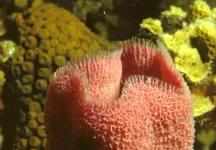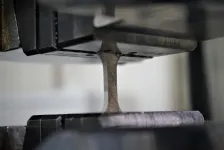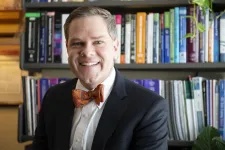Carbon-neutral 'biofuel' from lakes
Lakes could be suitable for the extraction of methane for energy production
2021-03-31
(Press-News.org) Lakes store huge amounts of methane. In a new study, environmental scientists at the University of Basel offer suggestions for how it can be extracted and used as an energy source in the form of methanol.
Discussion about the current climate crisis usually focuses on carbon dioxide (CO2). The greenhouse gas methane is less well known, but although it is much rarer in the atmosphere, its global warming potential is 80 to 100 times greater per unit.
More than half the methane caused by human activities comes from oil production and agricultural fertilizers. But the gas is also created by the natural decomposition of biomass by microbes, for example in lakes. In their most recent publication, researchers at the University of Basel in Switzerland outline the potential and theoretical possibilities for using methane from lakes and other freshwater bodies for sustainable energy production.
Methane from lakes and water reservoirs makes up about 20% of global natural methane missions. "That would theoretically be enough to meet the world's energy needs," says Maciej Bartosiewicz, a postdoc in the Department of Environmental Sciences of the University of Basel. Lakes continuously absorb CO2 from the atmosphere through the growth of phytoplankton. Microbes convert the carbon, fixed by photosynthesis, into methane when they process biomass. That way, carbon bound in the methane remains within the natural cycle during combustion. Fossil fuels could be partially replaced by "natural" renewable methane. Methane gas is already burned in gas-fired power plants for electricity production and used as a fuel in the form of liquid methanol.
Lakes as huge energy stores
The idea described in the article isn't completely new: since 2016, methane in Lake Kivu between Rwanda and the Democratic Republic of Congo has been extracted from a depth of 260 meters, cleaned and used for energy supply directly via generators. "Methane occurs in high concentrations in large quantities on the lake bed there," explains Bartosiewicz. "The methane concentration is about 100 times higher than in ordinary lakes." Low concentrations made extracting methane from conventional lakes seem too technically difficult until a few years ago. But new microporous membranes made of polymeric materials now allow the gas to be separated from the water much more efficiently.
The researchers have made the first concrete proposals in this regard: using a hydrophobic gas-liquid membrane contactor, a methane-containing gas mixture can be separated from water and the methane concentrated. Zeolite minerals are particularly suitable for enrichment, since hydrophobic crystalline substances can adsorb and release gases.
Potential positive effects on ecosystems
"With our idea, we wanted to start a broad discussion about the potential, feasibility and risks of a technology like this," says Bartosiewicz. "Until now, no studies have addressed the effects of methane removal on lake ecosystem functioning, but no immediate negative effects can be foreseen with our current understanding." However, removing excess carbon could even help curb excessive phytoplankton bloom formation and reduce natural greenhouse gas emissions from lakes. More work is needed before any practical implementation of this initial theoretical idea, says Bartosiewicz. But he's convinced: "This concept could one day make an important contribution to reaching our climate goals."
INFORMATION:
ELSE PRESS RELEASES FROM THIS DATE:
2021-03-31
Scientists from Trinity College Dublin believe they have pinpointed our most distant animal relative in the tree of life and, in doing so, have resolved an ongoing debate. Their work finds strong evidence that sponges - not more complex comb jellies - were our most distant relatives.
Sponges are structurally simple, lacking complex traits such as a nervous system, muscles, and a though-gut. Logically, you would expect these complex traits to have emerged only once during animal evolution - after our lineage diverged from that of sponges - and then be retained in newly evolved creatures thereafter.
However, a debate has been raging ever since phylogenomic studies found evidence that our most distant ...
2021-03-31
Superalloys that withstand extremely high temperatures could soon be tuned even more finely for specific properties such as mechanical strength, as a result of new findings published today.
A phenomenon related to the invar effect - which enables magnetic materials such as nickel-iron (Ni-Fe) alloys to keep from expanding with increasing temperature - was reported to have been discovered in paramagnetic, or weakly magnetized, high-temperature alloys.
Levente Vitos, Professor at KTH Royal Institute of Technology in Stockholm, says the breakthrough research, which includes a general theory explaining the new invar effect, promises to advance the design of high-temperature alloys with exceptional mechanical stability. The article was published in the Proceedings ...
2021-03-31
The higher the number of plant and bird species in a region, the healthier the people who live there. This was found by a new study published in Landscape and Urban Planning and led by the German Centre for Integrative Biodiversity Research (iDiv), the Senckenberg Biodiversity and Climate Research Centre (SBiK-F) and the Christian Albrechts University (CAU) in Kiel. The researchers found that, in particular, mental health and higher species diversity are positively related, whereas a similar relationship between plant or bird species and physical health could not be proven.
The study led by researchers from iDiv, SBiK-F and CAU provides ...
2021-03-31
University of Rochester researchers who demonstrated superconducting materials at room temperatures last fall, now report a new technique in the quest to also create the materials at lower pressures.
In a paper published in Physical Review Letters, the lab of Ranga Dias, assistant professor of mechanical engineering and of physics and astronomy, describes separating hydrogen atoms from yttrium with a thin film of palladium.
"This is a completely new technique that nobody has used before for high pressure superhydride synthesis," Dias says.
Hydrogen rich materials are critical in the ...
2021-03-31
As with any complex machine, sometimes a simple crossed wire or short circuit can cause problems with how it functions. The same goes for our brains, and even when the short circuit is uncovered, sometimes experts don't have a quick fix.
A new study reveals that an evidence-based treatment may "fix" this human short circuit and, with the help of brain imaging, might predict treatment outcomes for adolescents with anxiety disorders. University of Cincinnati researchers say this could determine medication effectiveness more quickly to help patients.
Study results showed that brain imaging was able to predict -- after just two weeks of treatment ...
2021-03-31
A targeted opioid that only treats diseased tissues and spares healthy tissues relieves pain from inflammatory bowel disease without causing side effects, according to new research published in the journal Gut.
The study, led by researchers at New York University College of Dentistry and Queen's University in Ontario, was conducted in mice with colitis, an inflammatory bowel disease marked by inflammation of the large intestine.
Opioids, which are used to treat chronic pain in people with inflammatory bowel disease, relieve pain by targeting opioid receptors, including the mu opioid receptor. When opioids activate the mu opioid receptor in healthy ...
2021-03-31
A team from the Universitat Politècnica de València (UPV) and the CIBER Bioengineering, Biomaterials and Nanomedicine (CIBER-BBN) has designed and tested, at a preclinical level, a new biomaterial for the treatment and recovery of muscle injuries. It is a boron-loaded alginate hydrogel, which would be administered with a subcutaneous injection. According to the tests carried out so far -in animal models-, it is capable of regenerating damaged muscle very rapidly -specifically, in half the time it takes for it to regenerate naturally.
The scientific advance could also be applied to the prevention and treatment of muscle atrophy associated with aging. The results of the work of these Spanish researchers have been published in the journal Materials Science & Engineering C.
The ...
2021-03-31
Research led by Michigan Medicine's Scleroderma Program and published in Arthritis & Rheumatology found that tocilizumab, a FDA-approved anti-inflammatory drug used to combat rheumatoid arthritis, can prevent lung disease in patients with systemic sclerosis if detected early enough in the disease course.
Systemic sclerosis is an autoimmune disease and the most serious form of scleroderma, the tightening and thickening of the skin. It can affect internal organs and lung disease is its leading cause of death, according to study author Dinesh Khanna, M.B.B.S., M.Sc., director of Michigan Medicine's Scleroderma Program.
"Some people have minimal lung disease; some people have life-threatening ...
2021-03-31
A team of neurobiologists at the Institut de Neurosciences de la Timone (CNRS/Aix-Marseille Université) has just shown that within a population of rats it can predict which will become cocaine addicts. One of the criteria for addiction in rats is the compulsive search for a drug despite its negative consequences. Scientists observed abnormal activity in a specific region of the brain, the subthalamic nucleus, only in future addicted individuals, and did so before they were exposed to 'punishment' associated with the seeking for the drug. These results, which have just been published online by PNAS, also indicate that it is possible to reduce this compulsive cocaine-seeking behaviour in rats by stimulating the subthalamic nucleus, confirming its interest ...
2021-03-31
Local alternative seafood networks (ASNs) in the United States and Canada, often considered niche segments, experienced unprecedented growth in the early months of the COVID-19 pandemic while the broader seafood system faltered, highlighting the need for greater functional diversity in supply chains, according to a new international study led by the University of Maine.
The spike in demand reflected a temporary relocalization phenomenon that can occur during periods of systemic shock -- an inverse yet complementary relationship between global and local seafood systems that contributes to the resilience of regional food systems, according to the research team, which published its findings in Frontiers in Sustainable ...
LAST 30 PRESS RELEASES:
[Press-News.org] Carbon-neutral 'biofuel' from lakes
Lakes could be suitable for the extraction of methane for energy production




